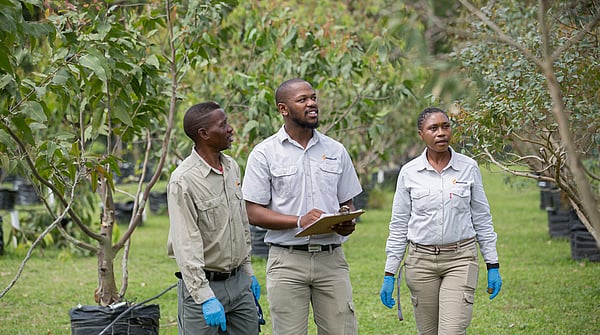How we monitor the biodiversity value of our South African forestry landholdings
.jpg?stamp=3b934dc56fa0c335350549d6cb4ff10d07843867)
Our sustainable working forest model frames the management of Mondi South Africas forestry landholdings.
We take our responsibility to manage the natural ecosystems on our landholdings for biodiversity value seriously, whilst also recognising that healthy, functional ecosystems - specifically the availability of water and healthy soils - underpin the long-term productivity of Mondi's tree growing operations. Learn more about how we manage ecosystems and source fibre responsibly.
Mondi manages approximately 256,000 hectares of landholdings across KwaZulu-Natal and southern Mpumalanga, with about 20% set aside for biodiversity conservation purposes. The conservation areas are dominated by grassland and wetland ecosystems, with natural forests and woodlands (savanna) ecosystems in some places.
.jpg?stamp=fc9b7ed38d7156311528cfcb0f3841bb13888c65)
Key principles of conservation corridors
These conservation corridors are the focus of a long-standing research partnership between Mondi and the University of Stellenbosch’s Department of Conservation Ecology and Entomology. The research findings have been developed into a set of key principles around the shape, size and placement of these conservation corridors on Mondi’s forestry landholdings, and how they should be managed to optimise their effectiveness in conserving biodiversity.
Through its biodiversity monitoring programme, Mondi South Africa’s forestry team uses expert environmental specialists to determine whether our management interventions are working to maintain the biodiversity values of these conservation areas, including avoiding or mitigating key risks from forestry operations or from negative influences outside our boundaries.
Key elements include:
- Selected parts of the ecological networks have been identified as high conservation value areas (HCVA). These HCVAs are subject to five-yearly flora and fauna assessments to determine if the species still occurring as expected.
- Wetlands monitoring assessments are carried out in each of our operational units on a four-yearly basis. A rapid wetlands assessments approach is undertaken in winter for a large sample of wetlands within a given operational unit, and then three wetlands are selected for more detailed summer assessments. The results are then workshopped with key operational staff to direct future management efforts.
- Two priority river ecosystems are subject to six-monthly freshwater monitoring assessments. Water quality is assessed where selected rivers enter and exit Mondi operations, using biomonitoring indices and water chemistry parameters. The water quality at the exit point should be the same or even better than it was when it entered the plantation. If not, then corrective action is required in terms of managing forestry operations or in terms of managing the riparian zones, wetlands and their buffers.
- Invasive alien plants (IAP) can have a negative impact on water and biodiversity and constitute a fire hazard. IAP assessments are undertaken annually by external experts to provide independent, objective assessment of the status of IAPs on our forestry landholdings. The results are then used to direct management efforts.
Ultimately, the focus of Mondi’s biodiversity monitoring programme is on ensuring that the results are analysed and used to direct management actions to maintain or improve biodiversity management performance going forward.
.jpg?stamp=0fc271fb79661bb6b5b336ffc881e34180dcd43a)
